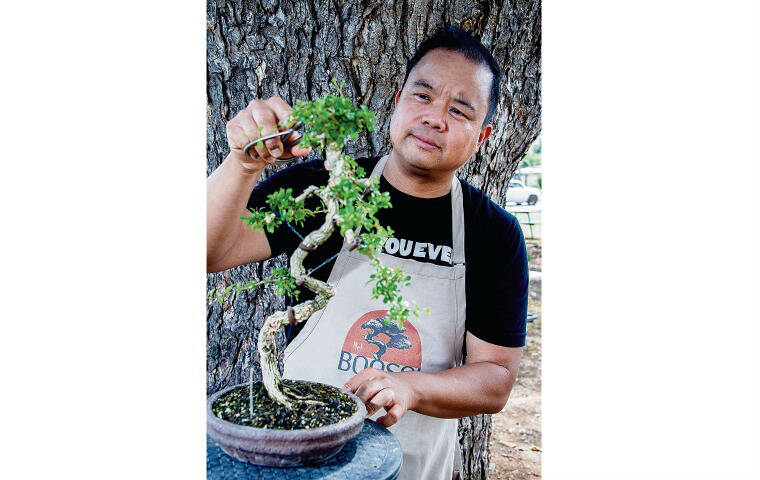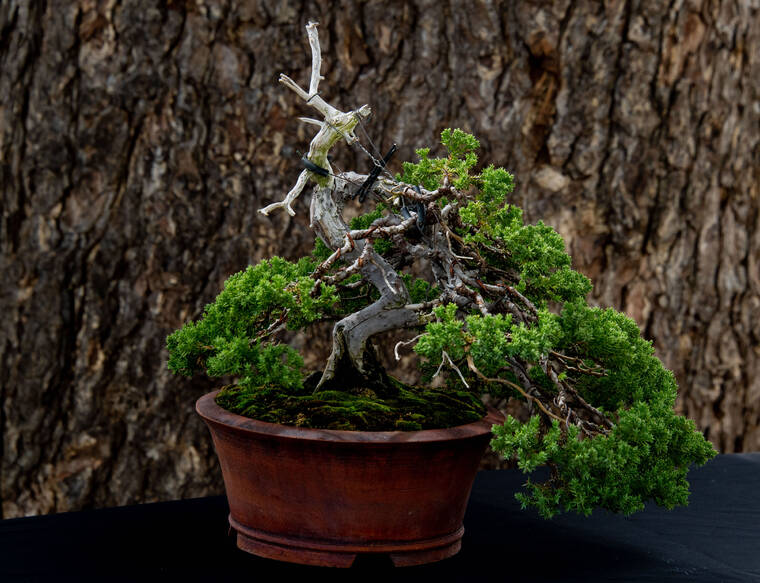Shaping a bonsai tree is a matter of art imitating life, a rewarding process that never ends.
“The ability to create a miniature tree in a pot that resembles a tree in nature is the ultimate goal of bonsai practitioners and is a lifelong journey of discovery, reflection and learning,” said Mel Carrillo, publicist for the Rainbow Bonsai Club. “The tree is never done, you have to constantly work at it … it’s like having a child almost.”
The club is all about helping beginners succeed at the start of their journey and gathering enthusiasts together to exchange their knowledge. Those who’ve always wanted to try their hand at bonsai will get the chance to learn the basic principles from bonsai artist and teacher Jason Chan of Southern California next weekend, courtesy of the club.
Chan, owner of the Eastern Leaf nursery and an online retailer in Chino, Calif., will give a free demonstration from 9 a.m. to 1 p.m. May 29 at the Koko Head Elementary School cafeteria; the demo will also will be livestreamed on Facebook. He authored the “Bonsai Pocket Guide: A Beginner’s Journey,” and is a prolific teacher on YouTube. Numerous plant vendors and an auction are also scheduled for the Rainbow club’s inaugural visiting artist event.
Chan will work on a raw, unshaped miniature juniper and demonstrate how to select the tree’s front, establish its basic design and teach the fundamentals of branch placement starting from the trunk base. Carrillo said most trees require aluminum or copper wiring of the branches to achieve a good design and allow even exposure to sunlight, which Chan will demonstrate.
Carrillo recommended that beginners find an experienced practitioner or join a club to get advice on how to choose a basic design, based on the individual characteristics of the tree, that will be easily sustainable as it grows. There are many bonsai designs, but the five basic styles include formal upright, informal upright, slanting, cascade and semi-cascade.
Rick Wagner, the club’s former president who is now serving as secretary, said the juniper and other evergreens are most commonly used in bonsai, but he has always favored flowering trees. Wagner began studying under eminent bonsai masters in the mid-1980s in Southern California and became president of one of its largest clubs, Dai Ichi Bonsai Kai. He retired as a spacecraft engineer in 2010 and moved to Hawaii with his wife, Andrea, who is also a member of the Rainbow club. Since then, Wagner has concentrated on tropical flowering plants with a woody structure, such as bougainvillea, ilima, hao and hibiscus.
Beginners may get the mistaken impression that bonsai design must rigidly conform to classic styles.
“There’s a lot of room for individuality, but you have to know what the rules are so you can know when to break them,” Wagner said. “In fact, there’s a Japanese style called ‘bungin,’ also known as ‘literati,’ that breaks all the rules, but it has to be done right to be aesthetically good.”
Most people who are self-taught mainly through reading usually quit in a couple of years after a few failures, as Wagner once did as a teenager. “I was really hesitant to join a club because I was afraid I wouldn’t be accepted, I was such a rank beginner,” Wagner said. “But if you really want to learn bonsai, seeing other people, getting advice and talking to other people is the way to do it.” Many people bring in their trees to the Rainbow club’s monthly meetings to receive input from members, of which about 25 are active.
Those most suited to take up bonsai have patience and the ability to keep their eye on long-term rewards, as it takes a good while for leaves and branches to grow into a desired style. And they also need dedication, he said.
“It’s like having pets — you really have to pay attention to them, and a lot of people don’t have it in them to do it right. Bonsai is not for everybody, but if you stick with it, it’s rewarding,” Wagner said.
Carrillo said beginners should start with a small, durable tree suited to the environment in which they live, as Hawaii’s microclimates vary widely. He recommends growing the tree in a 6- to 12-inch shallow pot; the depth of the pot should equal the trunk’s diameter.
Any standard pair of sharp scissors can be used temporarily in place of specialized equipment, he said. Most trees should be kept in a sunny location outdoors to grow best, and if necessary, placed under shadecloth to protect against the intensity of the sun; they can be brought indoors to admire for a couple of days.
“Learn how to water — that’s the No. 1, most important fundamental skill” to keep the tree alive, he said. A mix of aggregates, not soil, is used to insure an ideal balance of water and oxygen for the roots, Carrillo said. He uses his fingers to feel for moisture and checks the color of the substrate to see if more water is needed. Some growers leave a wooden chopstick in the pot that can be pulled out and checked for moisture.
Carrillo has more than 30 trees of the “shonin” size, 6 to 8 inches high. He waters them in the morning and when he returns from work (as a nurse/manager at The Queen’s Medical Center) as such miniature trees can dry out quickly.
But he warned against overwatering: “If you leave (the tree) too damp, you’re going to have dead roots; they’re going to get rotten.”
Fertilizer should be used sparingly, depending on whether rapid growth is desired or if it’s being used to maintain the current size. Carrillo recommended a balanced fertilizer, such as 10-10-10 NPK or 5-5-5 NPK, in addition to organic fertilizers such as fish emulsion or bone meal, to encourage mycorrhizal fungi.
It was Carrillo’s idea to launch the club’s visiting artist program to provide practitioners with innovative ideas and the latest techniques.
His devotion to bonsai began in the mid-1980s with the “Karate Kid” movie series, when he became fascinated with one of the main characters, Mr. Miyagi, and the Zen philosophy associated with bonsai.
“There’s a calming effect you get from it. It’s helped ground me literally, you know, like a tree into the practice of mindfulness,” he said laughing, pointing out the pun. “It gives you an opportunity to disconnect from the stresses of the real world and just focus your energy on the development of the tree.
“The tree is never done. … It will outgrow that style, and you will have to grow with the tree,” Carrillo said.
—
Free demonstration
California artist Jason Chan will lead a bonsai presentation.
>> When: 9 a.m. to 1 p.m. May 29
>> Where: Koko Head Elementary School cafeteria, 189 Lunalilo Home Road
>> Livestreamed on Rainbow Bonsai Club’s Facebook or YouTube Opens in a new tab pages
>> Email: rainbow bonsai@gmail.com
Is there a gardening topic you’d like to read about in the Garden Variety column? Email Pat Gee at pgee@staradvertiser.com with your request.




